weight DODGE DART 2013 PF / 1.G Owners Manual
[x] Cancel search | Manufacturer: DODGE, Model Year: 2013, Model line: DART, Model: DODGE DART 2013 PF / 1.GPages: 604, PDF Size: 4.72 MB
Page 63 of 604
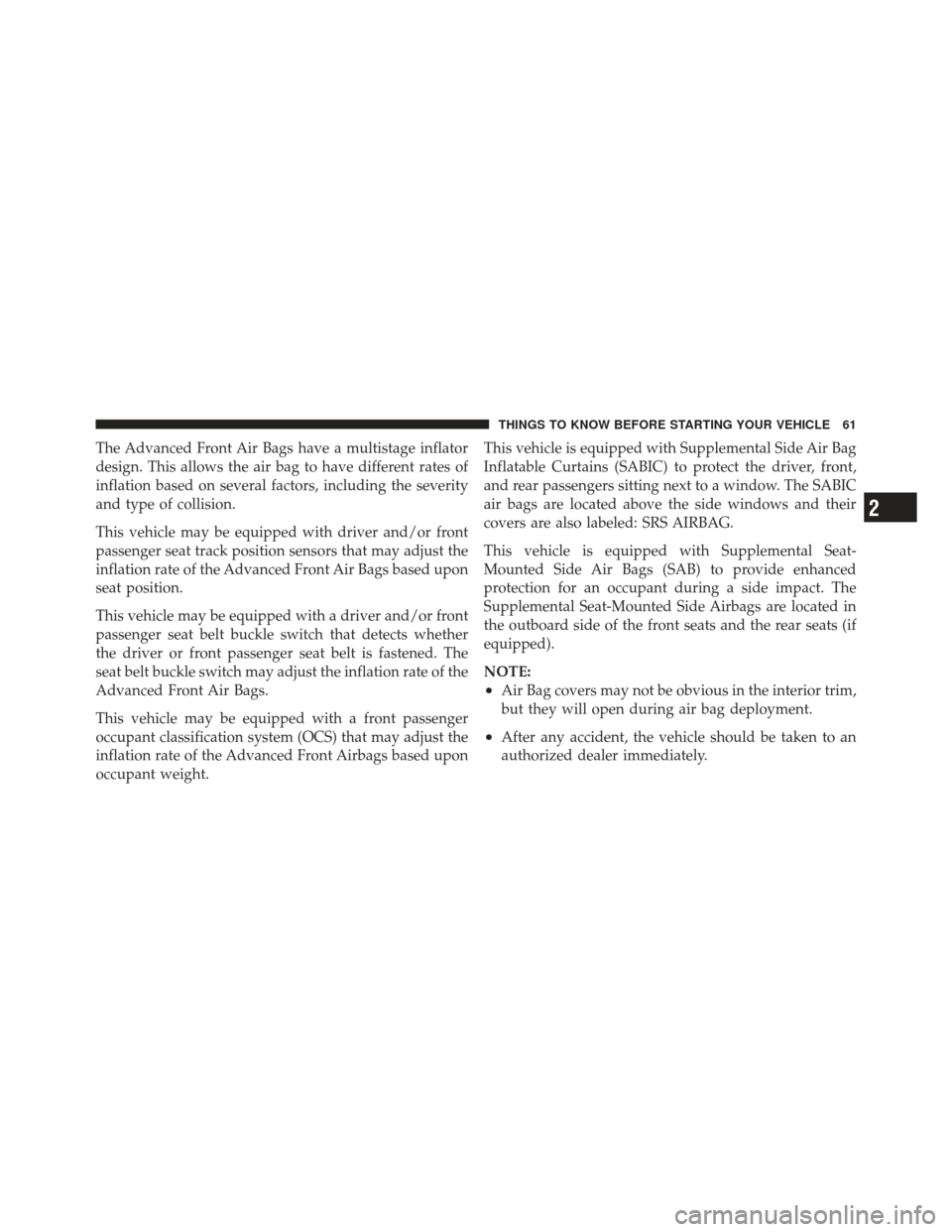
The Advanced Front Air Bags have a multistage inflator
design. This allows the air bag to have different rates of
inflation based on several factors, including the severity
and type of collision.
This vehicle may be equipped with driver and/or front
passenger seat track position sensors that may adjust the
inflation rate of the Advanced Front Air Bags based upon
seat position.
This vehicle may be equipped with a driver and/or front
passenger seat belt buckle switch that detects whether
the driver or front passenger seat belt is fastened. The
seat belt buckle switch may adjust the inflation rate of the
Advanced Front Air Bags.
This vehicle may be equipped with a front passenger
occupant classification system (OCS) that may adjust the
inflation rate of the Advanced Front Airbags based upon
occupant weight.This vehicle is equipped with Supplemental Side Air Bag
Inflatable Curtains (SABIC) to protect the driver, front,
and rear passengers sitting next to a window. The SABIC
air bags are located above the side windows and their
covers are also labeled: SRS AIRBAG.
This vehicle is equipped with Supplemental Seat-
Mounted Side Air Bags (SAB) to provide enhanced
protection for an occupant during a side impact. The
Supplemental Seat-Mounted Side Airbags are located in
the outboard side of the front seats and the rear seats (if
equipped).
NOTE:
•Air Bag covers may not be obvious in the interior trim,
but they will open during air bag deployment.
•After any accident, the vehicle should be taken to an
authorized dealer immediately.
2
THINGS TO KNOW BEFORE STARTING YOUR VEHICLE 61
Page 66 of 604
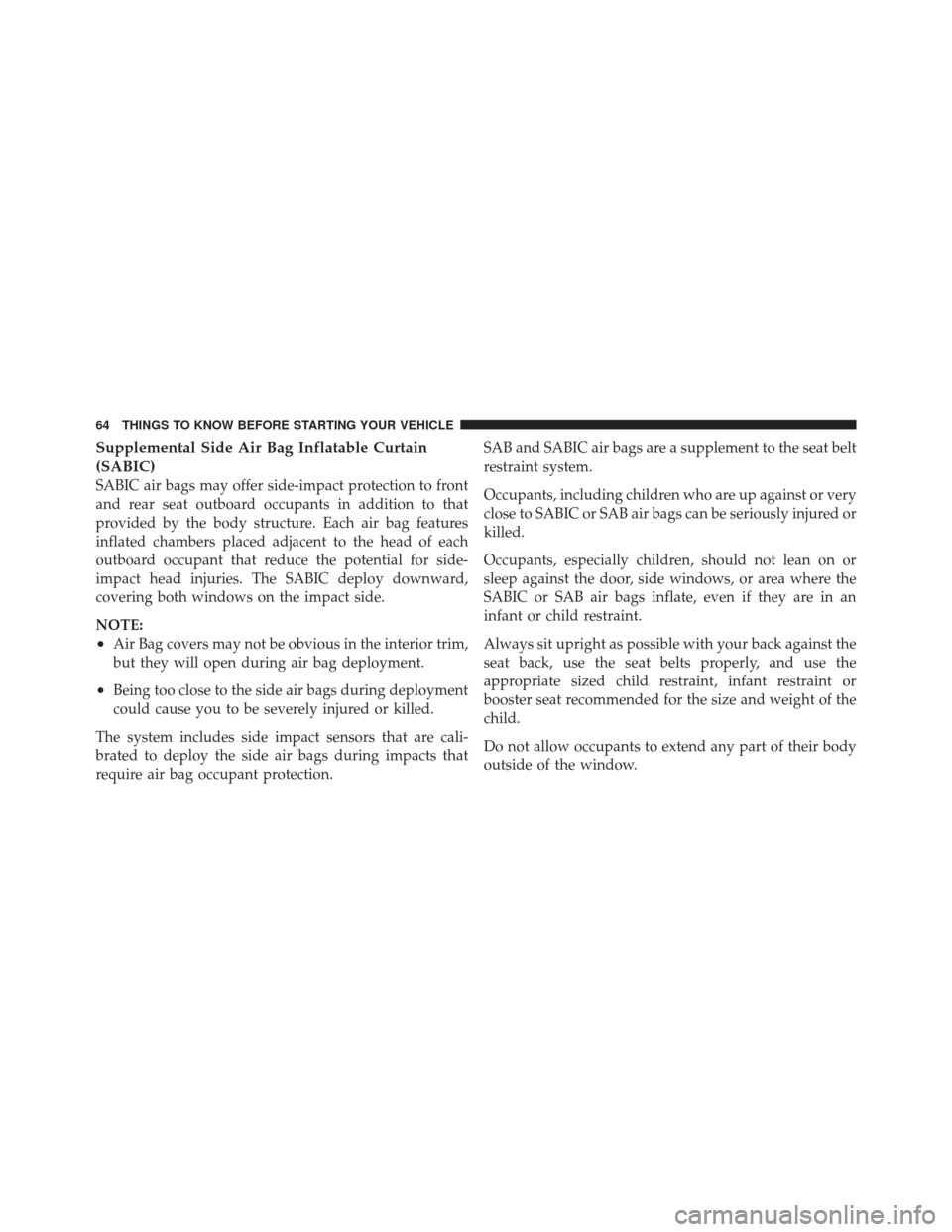
Supplemental Side Air Bag Inflatable Curtain
(SABIC)
SABIC air bags may offer side-impact protection to front
and rear seat outboard occupants in addition to that
provided by the body structure. Each air bag features
inflated chambers placed adjacent to the head of each
outboard occupant that reduce the potential for side-
impact head injuries. The SABIC deploy downward,
covering both windows on the impact side.
NOTE:
•Air Bag covers may not be obvious in the interior trim,
but they will open during air bag deployment.
•Being too close to the side air bags during deployment
could cause you to be severely injured or killed.
The system includes side impact sensors that are cali-
brated to deploy the side air bags during impacts that
require air bag occupant protection. SAB and SABIC air bags are a supplement to the seat belt
restraint system.
Occupants, including children who are up against or very
close to SABIC or SAB air bags can be seriously injured or
killed.
Occupants, especially children, should not lean on or
sleep against the door, side windows, or area where the
SABIC or SAB air bags inflate, even if they are in an
infant or child restraint.
Always sit upright as possible with your back against the
seat back, use the seat belts properly, and use the
appropriate sized child restraint, infant restraint or
booster seat recommended for the size and weight of the
child.
Do not allow occupants to extend any part of their body
outside of the window.
64 THINGS TO KNOW BEFORE STARTING YOUR VEHICLE
Page 70 of 604
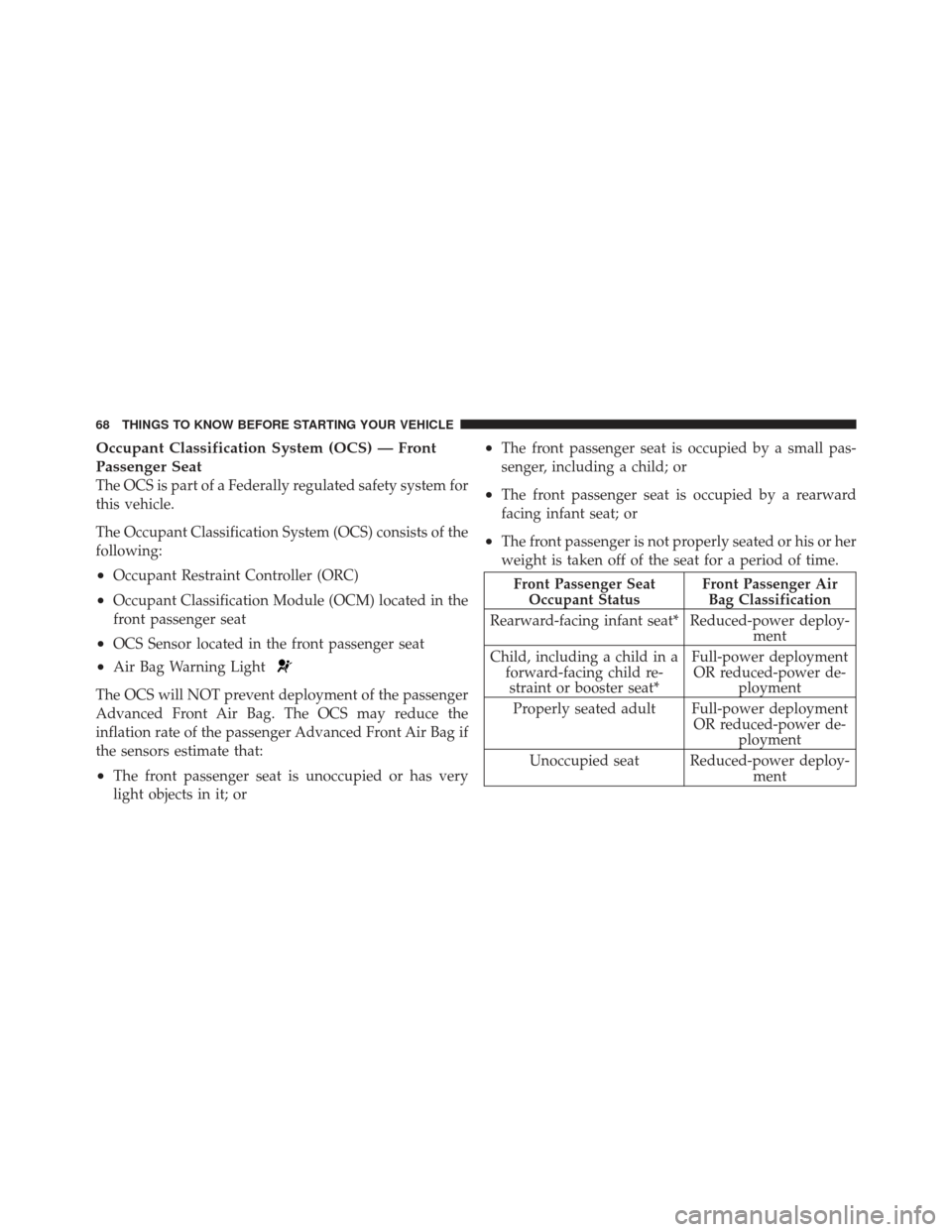
Occupant Classification System (OCS) — Front
Passenger Seat
The OCS is part of a Federally regulated safety system for
this vehicle.
The Occupant Classification System (OCS) consists of the
following:
•Occupant Restraint Controller (ORC)
•Occupant Classification Module (OCM) located in the
front passenger seat
•OCS Sensor located in the front passenger seat
•Air Bag Warning Light
The OCS will NOT prevent deployment of the passenger
Advanced Front Air Bag. The OCS may reduce the
inflation rate of the passenger Advanced Front Air Bag if
the sensors estimate that:
•The front passenger seat is unoccupied or has very
light objects in it; or
•The front passenger seat is occupied by a small pas-
senger, including a child; or
•The front passenger seat is occupied by a rearward
facing infant seat; or
•The front passenger is not properly seated or his or her
weight is taken off of the seat for a period of time.
Front Passenger SeatOccupant Status Front Passenger Air
Bag Classification
Rearward-facing infant seat* Reduced-power deploy- ment
Child, including a child in a forward-facing child re-straint or booster seat* Full-power deployment
OR reduced-power de- ployment
Properly seated adult Full-power deployment OR reduced-power de-ployment
Unoccupied seat Reduced-power deploy- ment
68 THINGS TO KNOW BEFORE STARTING YOUR VEHICLE
Page 71 of 604
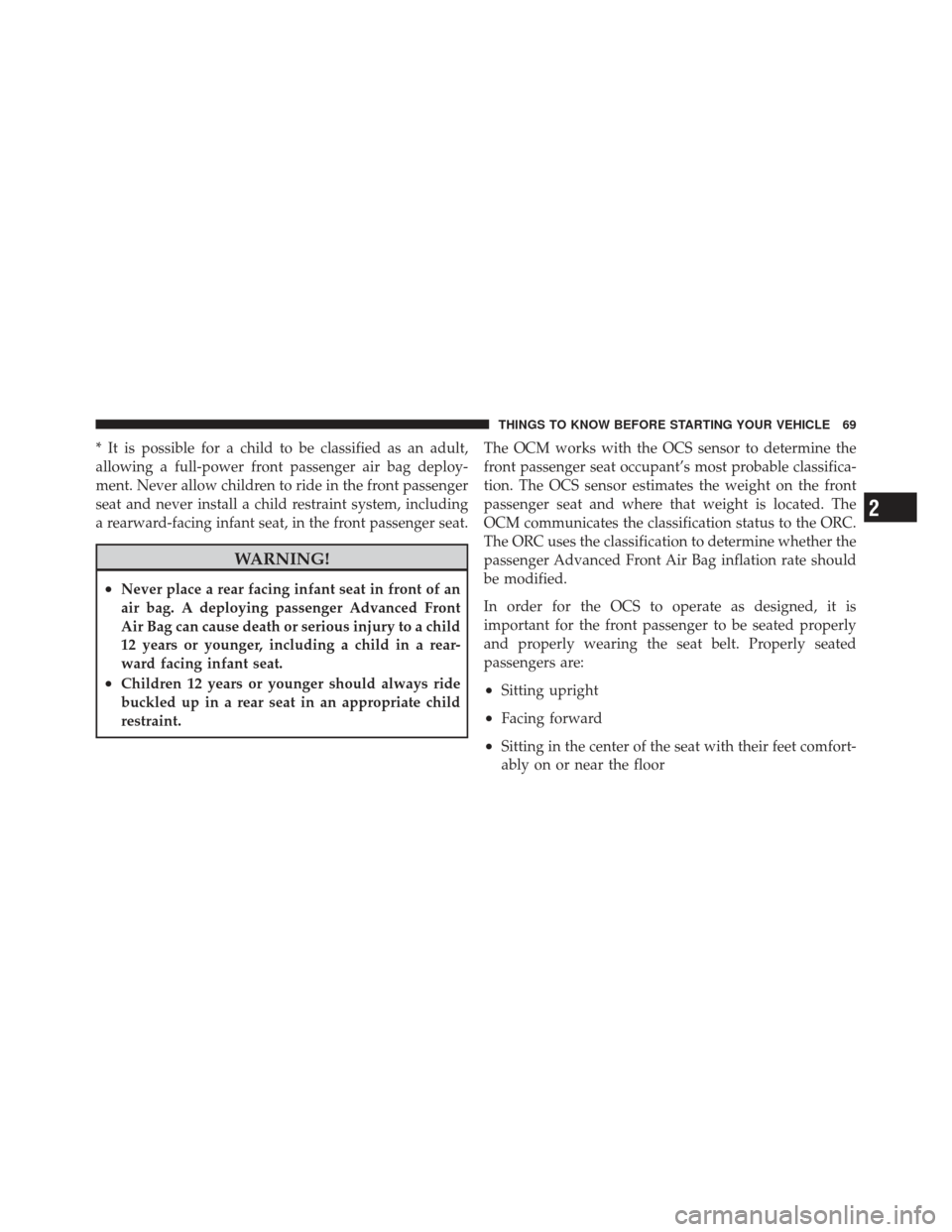
* It is possible for a child to be classified as an adult,
allowing a full-power front passenger air bag deploy-
ment. Never allow children to ride in the front passenger
seat and never install a child restraint system, including
a rearward-facing infant seat, in the front passenger seat.
WARNING!
•Never place a rear facing infant seat in front of an
air bag. A deploying passenger Advanced Front
Air Bag can cause death or serious injury to a child
12 years or younger, including a child in a rear-
ward facing infant seat.
•Children 12 years or younger should always ride
buckled up in a rear seat in an appropriate child
restraint.The OCM works with the OCS sensor to determine the
front passenger seat occupant’s most probable classifica-
tion. The OCS sensor estimates the weight on the front
passenger seat and where that weight is located. The
OCM communicates the classification status to the ORC.
The ORC uses the classification to determine whether the
passenger Advanced Front Air Bag inflation rate should
be modified.
In order for the OCS to operate as designed, it is
important for the front passenger to be seated properly
and properly wearing the seat belt. Properly seated
passengers are:•Sitting upright
•Facing forward
•Sitting in the center of the seat with their feet comfort-
ably on or near the floor
2
THINGS TO KNOW BEFORE STARTING YOUR VEHICLE 69
Page 72 of 604
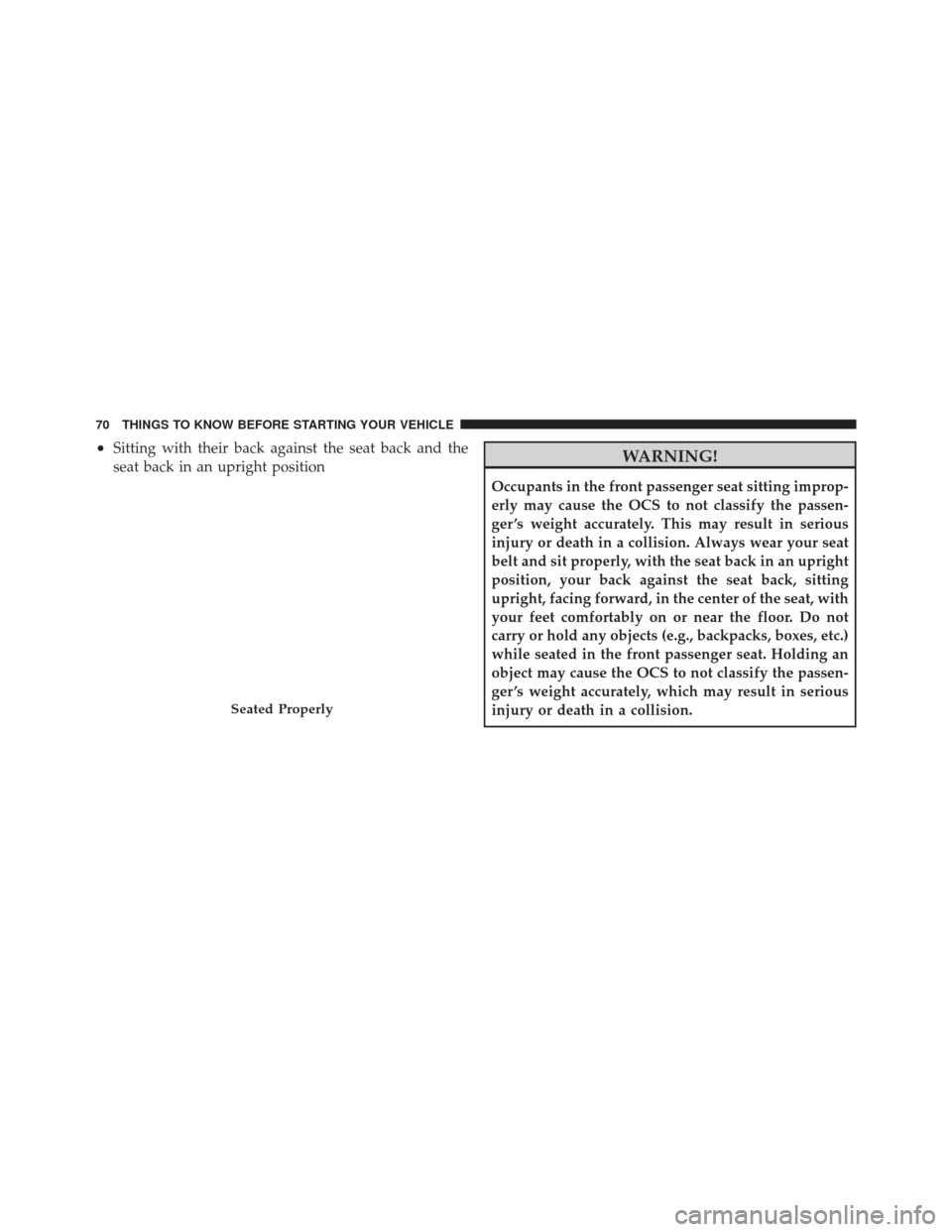
•Sitting with their back against the seat back and the
seat back in an upright positionWARNING!
Occupants in the front passenger seat sitting improp-
erly may cause the OCS to not classify the passen-
ger ’s weight accurately. This may result in serious
injury or death in a collision. Always wear your seat
belt and sit properly, with the seat back in an upright
position, your back against the seat back, sitting
upright, facing forward, in the center of the seat, with
your feet comfortably on or near the floor. Do not
carry or hold any objects (e.g., backpacks, boxes, etc.)
while seated in the front passenger seat. Holding an
object may cause the OCS to not classify the passen-
ger ’s weight accurately, which may result in serious
injury or death in a collision.
Seated Properly
70 THINGS TO KNOW BEFORE STARTING YOUR VEHICLE
Page 73 of 604
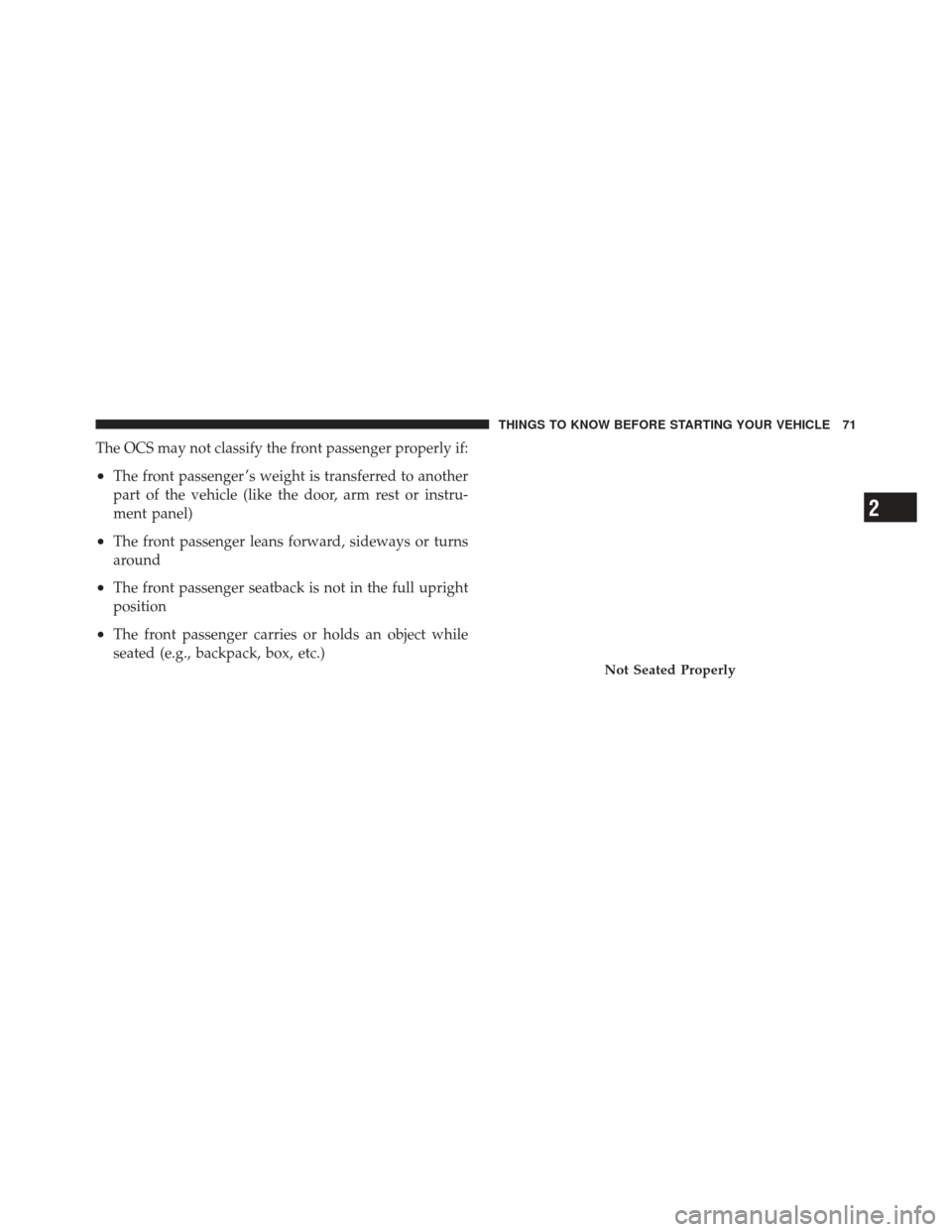
The OCS may not classify the front passenger properly if:
•The front passenger ’s weight is transferred to another
part of the vehicle (like the door, arm rest or instru-
ment panel)
•The front passenger leans forward, sideways or turns
around
•The front passenger seatback is not in the full upright
position
•The front passenger carries or holds an object while
seated (e.g., backpack, box, etc.)
Not Seated Properly
2
THINGS TO KNOW BEFORE STARTING YOUR VEHICLE 71
Page 76 of 604
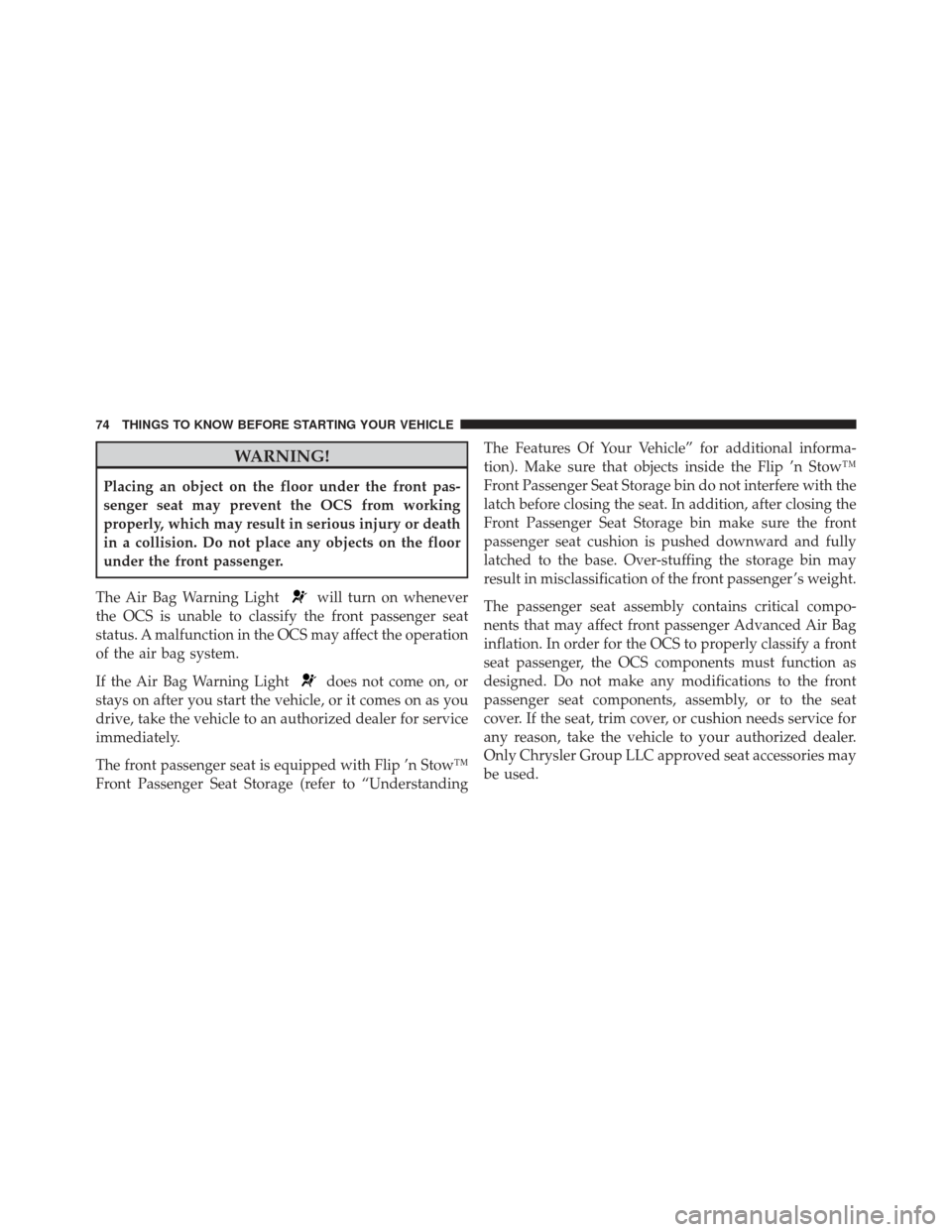
WARNING!
Placing an object on the floor under the front pas-
senger seat may prevent the OCS from working
properly, which may result in serious injury or death
in a collision. Do not place any objects on the floor
under the front passenger.
The Air Bag Warning Light
will turn on whenever
the OCS is unable to classify the front passenger seat
status. A malfunction in the OCS may affect the operation
of the air bag system.
If the Air Bag Warning Light
does not come on, or
stays on after you start the vehicle, or it comes on as you
drive, take the vehicle to an authorized dealer for service
immediately.
The front passenger seat is equipped with Flip ’n Stow™
Front Passenger Seat Storage (refer to “Understanding The Features Of Your Vehicle” for additional informa-
tion). Make sure that objects inside the Flip ’n Stow™
Front Passenger Seat Storage bin do not interfere with the
latch before closing the seat. In addition, after closing the
Front Passenger Seat Storage bin make sure the front
passenger seat cushion is pushed downward and fully
latched to the base. Over-stuffing the storage bin may
result in misclassification of the front passenger ’s weight.
The passenger seat assembly contains critical compo-
nents that may affect front passenger Advanced Air Bag
inflation. In order for the OCS to properly classify a front
seat passenger, the OCS components must function as
designed. Do not make any modifications to the front
passenger seat components, assembly, or to the seat
cover. If the seat, trim cover, or cushion needs service for
any reason, take the vehicle to your authorized dealer.
Only Chrysler Group LLC approved seat accessories may
be used.
74 THINGS TO KNOW BEFORE STARTING YOUR VEHICLE
Page 77 of 604
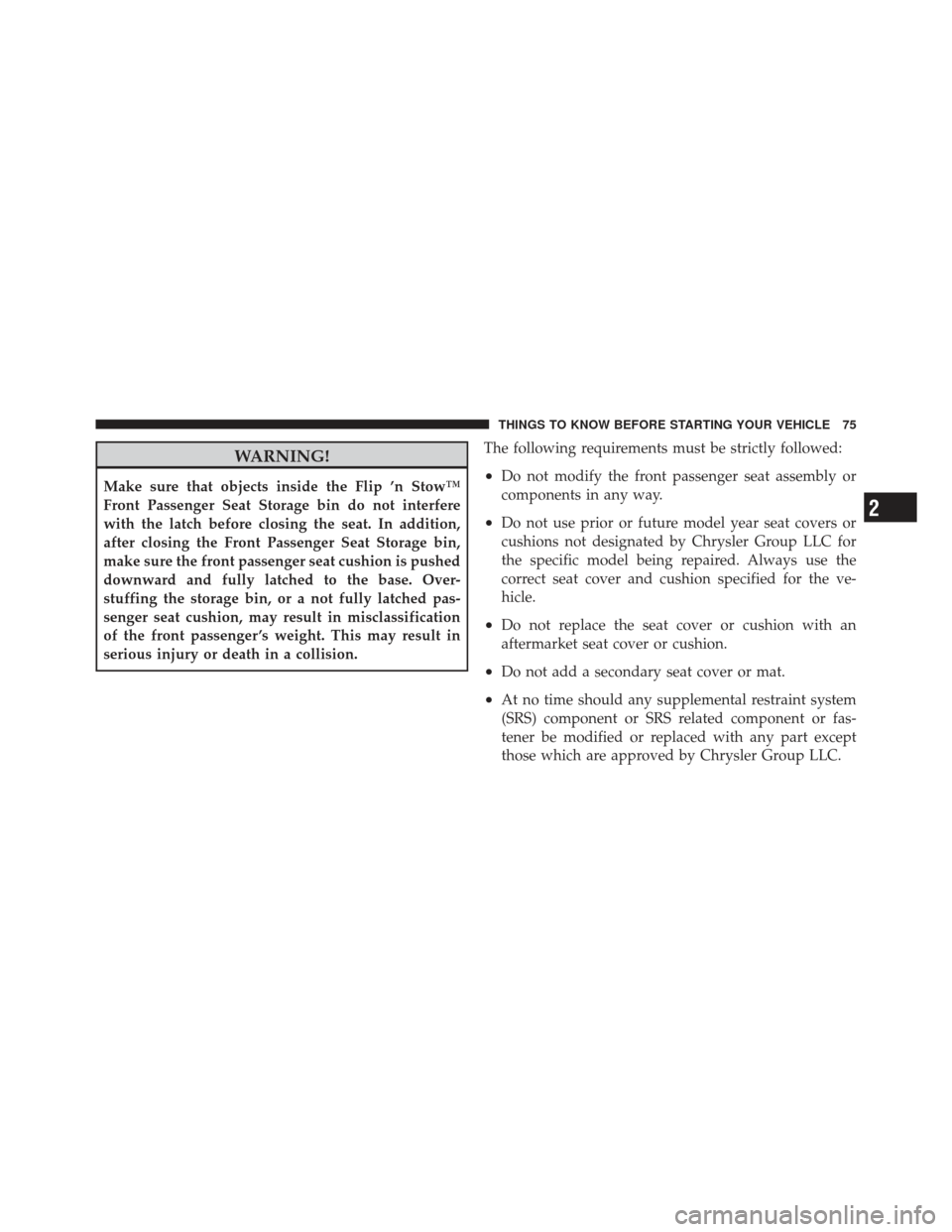
WARNING!
Make sure that objects inside the Flip ’n Stow™
Front Passenger Seat Storage bin do not interfere
with the latch before closing the seat. In addition,
after closing the Front Passenger Seat Storage bin,
make sure the front passenger seat cushion is pushed
downward and fully latched to the base. Over-
stuffing the storage bin, or a not fully latched pas-
senger seat cushion, may result in misclassification
of the front passenger ’s weight. This may result in
serious injury or death in a collision.The following requirements must be strictly followed:•Do not modify the front passenger seat assembly or
components in any way.
•Do not use prior or future model year seat covers or
cushions not designated by Chrysler Group LLC for
the specific model being repaired. Always use the
correct seat cover and cushion specified for the ve-
hicle.
•Do not replace the seat cover or cushion with an
aftermarket seat cover or cushion.
•Do not add a secondary seat cover or mat.
•At no time should any supplemental restraint system
(SRS) component or SRS related component or fas-
tener be modified or replaced with any part except
those which are approved by Chrysler Group LLC.
2
THINGS TO KNOW BEFORE STARTING YOUR VEHICLE 75
Page 86 of 604
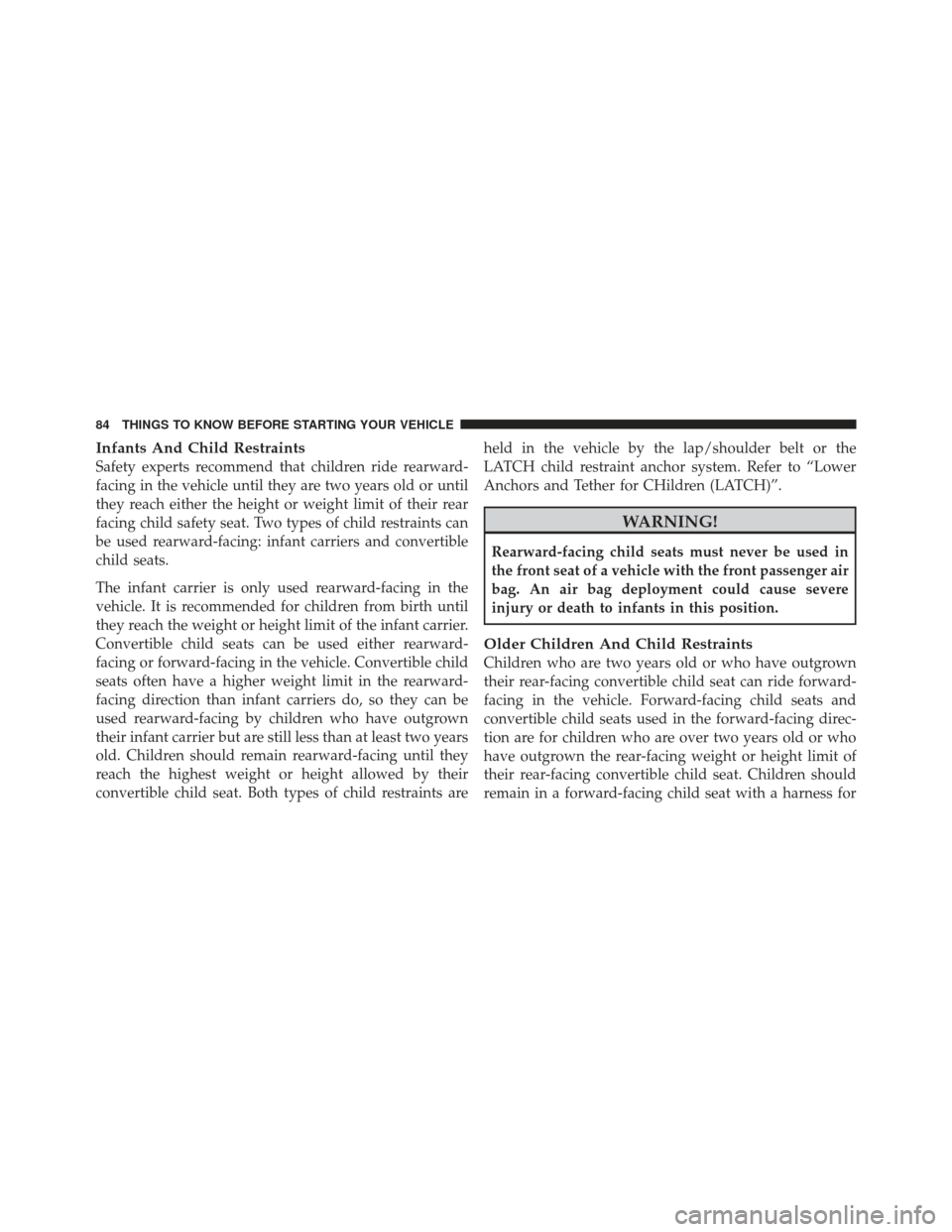
Infants And Child Restraints
Safety experts recommend that children ride rearward-
facing in the vehicle until they are two years old or until
they reach either the height or weight limit of their rear
facing child safety seat. Two types of child restraints can
be used rearward-facing: infant carriers and convertible
child seats.
The infant carrier is only used rearward-facing in the
vehicle. It is recommended for children from birth until
they reach the weight or height limit of the infant carrier.
Convertible child seats can be used either rearward-
facing or forward-facing in the vehicle. Convertible child
seats often have a higher weight limit in the rearward-
facing direction than infant carriers do, so they can be
used rearward-facing by children who have outgrown
their infant carrier but are still less than at least two years
old. Children should remain rearward-facing until they
reach the highest weight or height allowed by their
convertible child seat. Both types of child restraints areheld in the vehicle by the lap/shoulder belt or the
LATCH child restraint anchor system. Refer to “Lower
Anchors and Tether for CHildren (LATCH)”.
WARNING!
Rearward-facing child seats must never be used in
the front seat of a vehicle with the front passenger air
bag. An air bag deployment could cause severe
injury or death to infants in this position.
Older Children And Child Restraints
Children who are two years old or who have outgrown
their rear-facing convertible child seat can ride forward-
facing in the vehicle. Forward-facing child seats and
convertible child seats used in the forward-facing direc-
tion are for children who are over two years old or who
have outgrown the rear-facing weight or height limit of
their rear-facing convertible child seat. Children should
remain in a forward-facing child seat with a harness for
84 THINGS TO KNOW BEFORE STARTING YOUR VEHICLE
Page 87 of 604
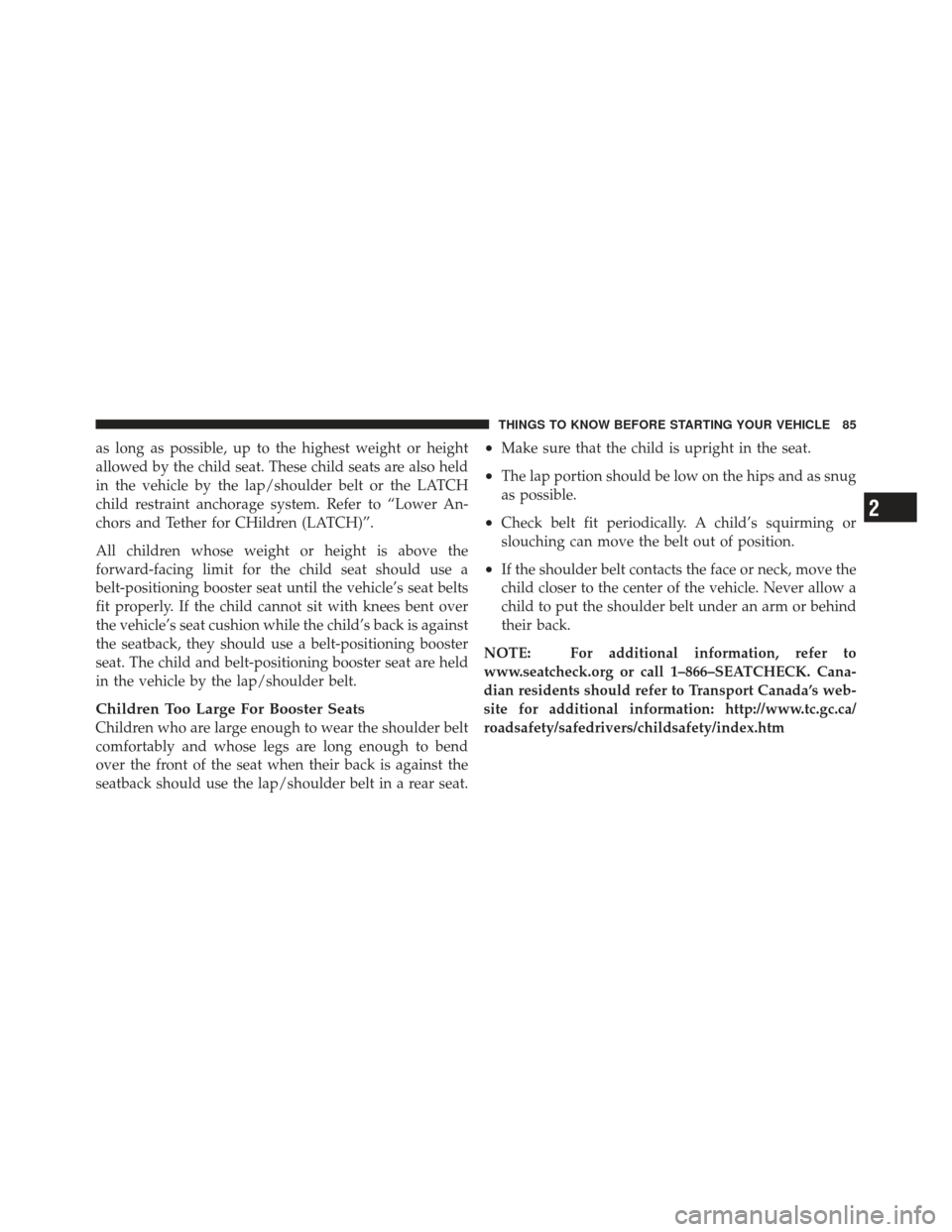
as long as possible, up to the highest weight or height
allowed by the child seat. These child seats are also held
in the vehicle by the lap/shoulder belt or the LATCH
child restraint anchorage system. Refer to “Lower An-
chors and Tether for CHildren (LATCH)”.
All children whose weight or height is above the
forward-facing limit for the child seat should use a
belt-positioning booster seat until the vehicle’s seat belts
fit properly. If the child cannot sit with knees bent over
the vehicle’s seat cushion while the child’s back is against
the seatback, they should use a belt-positioning booster
seat. The child and belt-positioning booster seat are held
in the vehicle by the lap/shoulder belt.
Children Too Large For Booster Seats
Children who are large enough to wear the shoulder belt
comfortably and whose legs are long enough to bend
over the front of the seat when their back is against the
seatback should use the lap/shoulder belt in a rear seat.
•Make sure that the child is upright in the seat.
•The lap portion should be low on the hips and as snug
as possible.
•Check belt fit periodically. A child’s squirming or
slouching can move the belt out of position.
•If the shoulder belt contacts the face or neck, move the
child closer to the center of the vehicle. Never allow a
child to put the shoulder belt under an arm or behind
their back.
NOTE: For additional information, refer to
www.seatcheck.org or call 1–866–SEATCHECK. Cana-
dian residents should refer to Transport Canada’s web-
site for additional information: http://www.tc.gc.ca/
roadsafety/safedrivers/childsafety/index.htm
2
THINGS TO KNOW BEFORE STARTING YOUR VEHICLE 85